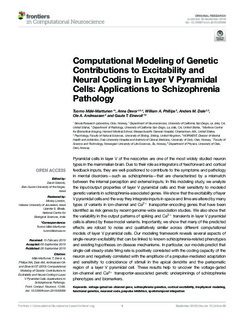| dc.contributor.author | Mäki-Marttunen, Tuomo | |
| dc.contributor.author | Devor, Anna | |
| dc.contributor.author | Phillips, William A | |
| dc.contributor.author | Dale, Anders M. | |
| dc.contributor.author | Andreassen, Ole Andreas | |
| dc.contributor.author | Einevoll, Gaute | |
| dc.date.accessioned | 2020-01-14T16:36:27Z | |
| dc.date.available | 2020-01-14T16:36:27Z | |
| dc.date.created | 2019-11-14T10:20:19Z | |
| dc.date.issued | 2019 | |
| dc.identifier.citation | Frontiers in Computational Neuroscience, 2019, 13:66 | nb_NO |
| dc.identifier.issn | 1662-5188 | |
| dc.identifier.uri | http://hdl.handle.net/11250/2636281 | |
| dc.description.abstract | Pyramidal cells in layer V of the neocortex are one of the most widely studied neuron types in the mammalian brain. Due to their role as integrators of feedforward and cortical feedback inputs, they are well-positioned to contribute to the symptoms and pathology in mental disorders—such as schizophrenia—that are characterized by a mismatch between the internal perception and external inputs. In this modeling study, we analyze the input/output properties of layer V pyramidal cells and their sensitivity to modeled genetic variants in schizophrenia-associated genes. We show that the excitability of layer V pyramidal cells and the way they integrate inputs in space and time are altered by many types of variants in ion-channel and Ca2+ transporter-encoding genes that have been identified as risk genes by recent genome-wide association studies. We also show that the variability in the output patterns of spiking and Ca2+ transients in layer V pyramidal cells is altered by these model variants. Importantly, we show that many of the predicted effects are robust to noise and qualitatively similar across different computational models of layer V pyramidal cells. Our modeling framework reveals several aspects of single-neuron excitability that can be linked to known schizophrenia-related phenotypes and existing hypotheses on disease mechanisms. In particular, our models predict that single-cell steady-state firing rate is positively correlated with the coding capacity of the neuron and negatively correlated with the amplitude of a prepulse-mediated adaptation and sensitivity to coincidence of stimuli in the apical dendrite and the perisomatic region of a layer V pyramidal cell. These results help to uncover the voltage-gated ion-channel and Ca2+ transporter-associated genetic underpinnings of schizophrenia phenotypes and biomarkers. | nb_NO |
| dc.language.iso | eng | nb_NO |
| dc.rights | Attribution-NonCommercial-NoDerivatives 4.0 Internasjonal | * |
| dc.rights.uri | http://creativecommons.org/licenses/by-nc-nd/4.0/deed.no | * |
| dc.title | Computational Modeling of Genetic Contributions to Excitability and Neural Coding in Layer V Pyramidal Cells: Applications to Schizophrenia Pathology | nb_NO |
| dc.type | Journal article | nb_NO |
| dc.type | Peer reviewed | nb_NO |
| dc.description.version | publishedVersion | nb_NO |
| dc.source.volume | 13 | nb_NO |
| dc.source.journal | Frontiers in Computational Neuroscience | nb_NO |
| dc.identifier.doi | 10.3389/fncom.2019.00066 | |
| dc.identifier.cristin | 1747423 | |
| cristin.unitcode | 192,0,0,0 | |
| cristin.unitname | Norges miljø- og biovitenskapelige universitet | |
| cristin.ispublished | true | |
| cristin.fulltext | original | |
| cristin.qualitycode | 1 | |

